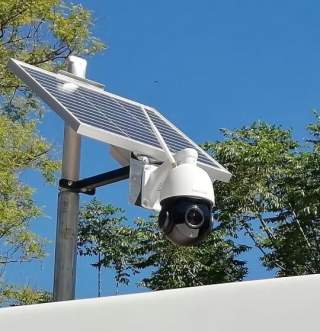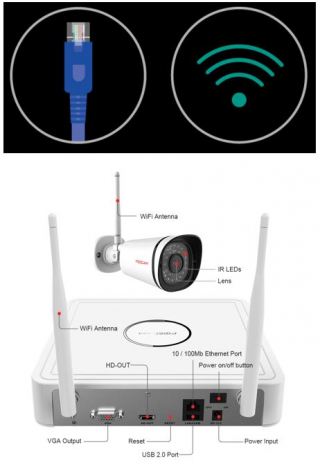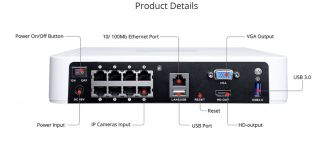FOSCAM Solar kits for security cameras and some common FAQ
I thought I should try to shed some light on our FOSCAM Solar kits, some common misconceptions and why we at Foscam have chosen to use lifepo4 batteries in our Solar kits.
The most common batteries used in solar energy storage typically are made with one of two chemical compositions: lead acid or lithium ion. In most cases, lithium ion batteries are the best option for a solar panel system, though other battery types can be more affordable.
1. Lead acid
Lead acid batteries are a tested technology that has been used in off-grid energy systems for decades. While they have a relatively short life and lower DoD than other battery types, they are also one of the least expensive options.
2. Lithium ion
Lithium ion batteries are lighter and more compact than lead acid batteries. They also have a higher DoD and longer lifespan when compared to lead acid batteries. However, lithium ion batteries are more expensive than their lead acid counterparts.
Frequently asked Questions are:
- How long will my batteries last before I need to replace them?
- A typical solar battery has a lifespan of between 5 and 15 years
- This depends on a few factors, how many times or cycles the batteries are depleted and recharged the DoD (explained below), the type of charge controller and the settings used to optimize your charge and discharge cycle.
- Here at Foscam we pay close attention to the recommended depth of discharge or DoD. DoD is the percentage of the battery’s stored energy you use. For example, your battery’s capacity is 13.5 kWh, and you use 10 kWh of its charge. The depth of discharge would be 74%.
- DoD is important because pushing your battery beyond its recommended DoD can significantly shorten your battery’s lifespan (the lower the DoD, the longer the life span and vice-versa). Manufacturers will assign each battery type a recommended maximum DoD. If your charge controller is not correctly configured you can kill your batteries in a few months, one setting does not fit all.
- How long will my batteries last without sun (dark run time) before they are flat?
- Foscam’s kits are designed to be used with the supplied equipment, that’s because we carefully match the connected equipment’s total power needs to the battery’s supped along with the panels recharge capacity. If you add or change the power consumption by adding more or different equipment it will affect the dark runtime.
- For example using our standard 12ah Solar System and connecting 1 Foscam camera we calculate a 30hr to 40hr run-time (Winter solstice), if you now add a POE CPE device like a TP-Link CPE510 to the pole then you run time drops to 20hr to 31hr run-time (Winter solstice). That’s a 10 hour reduction.
- Keep in mind that the minimum you need is 12 hours (summer solstice, Southern hemisphere), , that will only cover you for a one night, if the next day is very overcast and rainy then your system will go offline.
- It a trade off of price and weight v runtime, but most users accept that there will be a few days in year that they will be offline.
- If runtime is important to you then look at our 25Ah kit
- https://www.foscam.co.za/solar/156-fos-sol-k24ah.html
- Can I connect my own equipment to the Foscam solar kit?
- We give you a USB 5V, a 12V regulated, and a 12V unregulated hand-off. You can connect any additional equipment (max 600ma) to a Foscam standard system, but we then cant can’t grantee guarantee runtimes as advertised / stated as we have no idea of the power requirements of your equipment.
Lithium-ion batteries – life span
The predominant questions on any battery powered device are undoubtedly: how long will it last and what is the warranty. Warranty is certainly important, though not the only factor to consider when evaluating your solar battery options: price, performance, and durability should all be taken into account.
Similar to your laptop or cell phone battery, solar batteries degrade over time: as you continue to use and charge your battery, it loses the ability to hold a charge.
However, it’s important to not evaluate battery warranties based on charge – discharge cycles alone; because solar batteries gradually lose their ability to hold a full charge as they age, a cycle towards the end of your battery’s life will store and produce less energy than the output of a cycle immediately after installation.
Standard manufacturer warranties for lithium-ion batteries covering both performance and defects is one year, but extended warranties are available for purchase from some manufacturers. A warranty beyond 10 years does not make sense because so much of the battery would need to be replaced after year 10. As a comparison, a lead acid battery (such as in your car) and a gel battery (such as in your alarm system, UPS or automatic gate), has a life span of 3 to 5 years. For big installations, insurance can also be purchased by the user. Operations and maintenance of batteries is complicated because the normal tendency of the operator is ‘install and forget’. Rates of deterioration of the battery depend on how the battery is used.
With the above in mind, this is why most battery manufacturers today are quoting a battery’s ‘throughput warranty’. A ‘throughput warranty’ is the total energy a manufacturer expects the battery to deliver throughout its lifetime. These warranties are typically stated in terms of megawatt-hours (MWh).
Because the output from cycling your battery pack will diminish as the years go on and the fact that a battery pack is made up of many individual cells, defining an exact lifespan based upon warrantied cycles alone is very difficult. As an OEM we do not establish the cycle warranty of the battery pack but quote the battery manufacturer’s specifications.
Why choose LiFePO4 deep cycle batteries?
The life of a lead-acid battery is greatly affected by the DOD. A lead-acid battery is likely to fail quickly on a user as it normally only allows 25% to 40% (up to 60% sporadically) DOD.
In contrast, a LiFePO4 (Lithium Iron Phosphate) battery, which is newer technology, has a deep-cycle discharge, so it can reach 2000 cycles with 100% DOD. Lithium batteries can also be discharged at a specific C-rating. With a working temperature of 25° C and a discharge rate of 0.5C, a LiFePO4 battery can reach 4000 to 6000 cycles.
With a working temperature of 25° C (a higher temperature affects the figures quoted below) and a discharge rate of between 0.2C and 0.5C (the battery C Rating is the measurement of current in which a battery is charged and discharged at), a LiFePO4 battery can reach 1000 to 6000 cycles. Compared to lead-acid batteries which have a life cycle of between 500 and 2100 cycles, the advantages of deep-cycle lifepo4 batteries are the following: Eco-friendly; Good high-temperature resistance; higher DOD.
What is DOD (Depth of Discharge)? The Depth of Discharge (DOD) of a battery represents the percentage of the battery that has been discharged relative to the overall capacity of the battery.
A battery’s “cycle life,” the number of charge/discharge cycles in its life, depends on how much battery capacity is typically used. Rather than completely draining a battery to its maximum DOD, a user will be able to attain more cycles in their battery regularly discharging it with a lower percentage of charge.
For example, a battery may have 15,000 cycles at a DoD of 10%, but only have 3,000 cycles at a DoD of 80%.
With the Foscam solar systems, the aim is for a large number of cycle lives, and a stable discharge performance whilst giving the user the best possible ‘dark time’ (no solar charging available). The more equipment added to the solar system, the higher the DOD.
Compared to lead-acid batteries, the advantages of deep-cycle lifepo4 batteries are the following:
- Eco-friendly
- Good high-temperature resistance
- Good safety characteristics
- No memory effect
- Higher-capacity compare with same size lead-acid battery
- Longer cycle life than other lithium-ion batteries
- Ideal drop-in replacement for lead-acid batteries
- Lower total cost of average use
Please feel free to browse our range of solar kits and if you have a special requirement, we will happily quote you a bespoke system, contact us at This email address is being protected from spambots. You need JavaScript enabled to view it..
Are Wi-Fi security cameras a viable alternative?
Over the past few years there has been a significant growth in the availability of Wi-Fi enabled security cameras. Foscam is probably one of the biggest and oldest players in this market. They first came into popularity as Nanny Cams, used indoors to keep an eye on your family and pets. But now they have moved into the domain of serious mainstream indoor and outdoor security CCTV.
But are they any good? The short answer is yes, if used for the appropriate location with the correct infrastructure. One of the greatest criticisms is reliability, how often have you heard that you can’t trust Wi-Fi? Yet we use Wi-Fi to connect our phones, our laptops and computers, we use Wi-Fi to connect our smart TV and stream movies, we use if for alarms and almost everything. The days of the traditional cable CCTV camera are numbered. Both big business and the smaller domestic consumer are typically relying more and more on Wi-Fi than cable. The key to a successfull deployment of Wi-Fi security cameras lies in the Wi-Fi infrastructure, not the camera. Just like your cell phone, if it can’t connect to your Wi-Fi network then your camera probably won’t either. For a simple nanny cam like the Foscam C2 or R2 a normal Wi-Fi router sitting in the study will be sufficient. Simply power the camera up, join the Wi-Fi and away you go. But when you start wanting to monitor your main gate, pool area, etc things can get tricky. There are normally a few thick concrete walls between your study and where you want to place your camera. So most people then turn to running a network cable to the camera, but is that the most effective solution? Surely its more practical to extend your Wi-Fi , that way you cover a previously “dead” region and now you can add many new devises, from your cell phone to cameras.
Wi-Fi has come a long way, the options are varied from mesh (High density of devices) to point to point (for long distance, up to 8 km great for farm or large commercial applications along with solar) options. The TP Link Powerline range is also often a viable solution by using your buildings electrical wiring to deliver a Wi-Fi access point at any plug in your home? The trick is to not overload your access point, plan your Wi-Fi correctly and spread your cameras over two or more access points correctly placed and you can benefit from great Wi-Fi coverage all over your property including your garden as well as having the freedom to place your cameras anywhere you choose, two birds with one stone.
The TP Link Powerline range is also often a viable solution by using your buildings electrical wiring to deliver a Wi-Fi access point at any plug in your home? The trick is to not overload your access point, plan your Wi-Fi correctly and spread your cameras over two or more access points correctly placed and you can you can benefit from great Wi-Fi coverage all over your property including your garden as well as having the freedom to place your cameras anywhere you choose, two birds with one stone.
One of my favourite budget entry level Wi-Fi router/access points is the TOTO-LINK N300RH 300Mbps High Gain Wireless N Router, this is cost effective 11DB router that punches through walls like a knife through butter. I have regularly placed one in the roof of a large home and connected 6 to 8 cameras to it, from the driveway gate to the pool boundary wall. For larger homes two of these placed correctly does the job.
For smaller homes and business the Foscam FN3104W-B4 kit even comes with its own NVR with built-in Wi-Fi, so all you need to do is plug a network cable in from router to the NVR, turn it on and away you go. No configuration as the cameras come already paired to the NVR’s Wi-Fi. They can however join your existing Wi-Fi or even use a normal network cable if you wish.
Foscam South Africa is the authorised distributor of the Foscam brand in South Africa, we support and guarantee our products locally and passionately believe in the future of Wi-Fi enabled cameras. We have 8 over years of experience in supplying, advising and installing Wi-Fi security cameras. For any trade or purchase queries please contact us at This email address is being protected from spambots. You need JavaScript enabled to view it.
Foscam launches its new FN7108HE PoE NVR
Foscam is a leading DIY IP security video (cctv) solution that is known for its quality and ease of use enabling the average person to secure their home or business without having to resort to costly instillation service providers and as such, Foscam South Africa are excited to release their new and enhanced 8 channel PoE(power over Ethernet) NVR all in one unit to extend their range of products. A NVR is the heart of many bigger surveillance systems and this new high definition network video recorder (NVR) can support up to 8 high definition IP security cameras, both WiFi and PoE cameras.
The FN7108HE is also able to support 3rd party ONVIF cameras both regular and PoE. Where this NVR shines is its ease of use and setup from adding your cameras to remote viewing offsite. This recorder is easy to install, just connect your cameras directly to the back of the NVR with any Foscam PoE enabled camera, no need for a separate PoE switch or injectors. It will also support Foscam WiFi security cameras on your WiFi network by way of the built in Lan port.The ability to playback video footage on 4 channels simultaneously lets you go back to different days, hours or minutes, enabling you quickly scan 4 cameras at a time thus saving you time to find that footage you need.
The FN7108HE NVR PoE is able to record 24/7 or you can setup a suitable schedule based on motion detection so as you never miss out on the action. The new NVR/PoE is able to accommodate up to 4 TB surveillance hard drive. At Foscam South Africa we always recommend the WD Purple drive for quality recording. Please note that the hard drive is not included.
When buying Foscam IP security cameras for surveillance it is always a good idea to also be able to record what your cameras are seeing and now with this all in one unit you can. It supports HD video streams, built-in POE and you can connect your existing traditional wired cameras as well as your WiFi cameras. True 1080P full Hd Image provides important details such as facial features which you can store and replay when needed.
For more information or technical advise please contact us at Foscam and one of our helpful team will gladly assist you.
FOSCAMwww.foscam.co.za
011 465-9173




